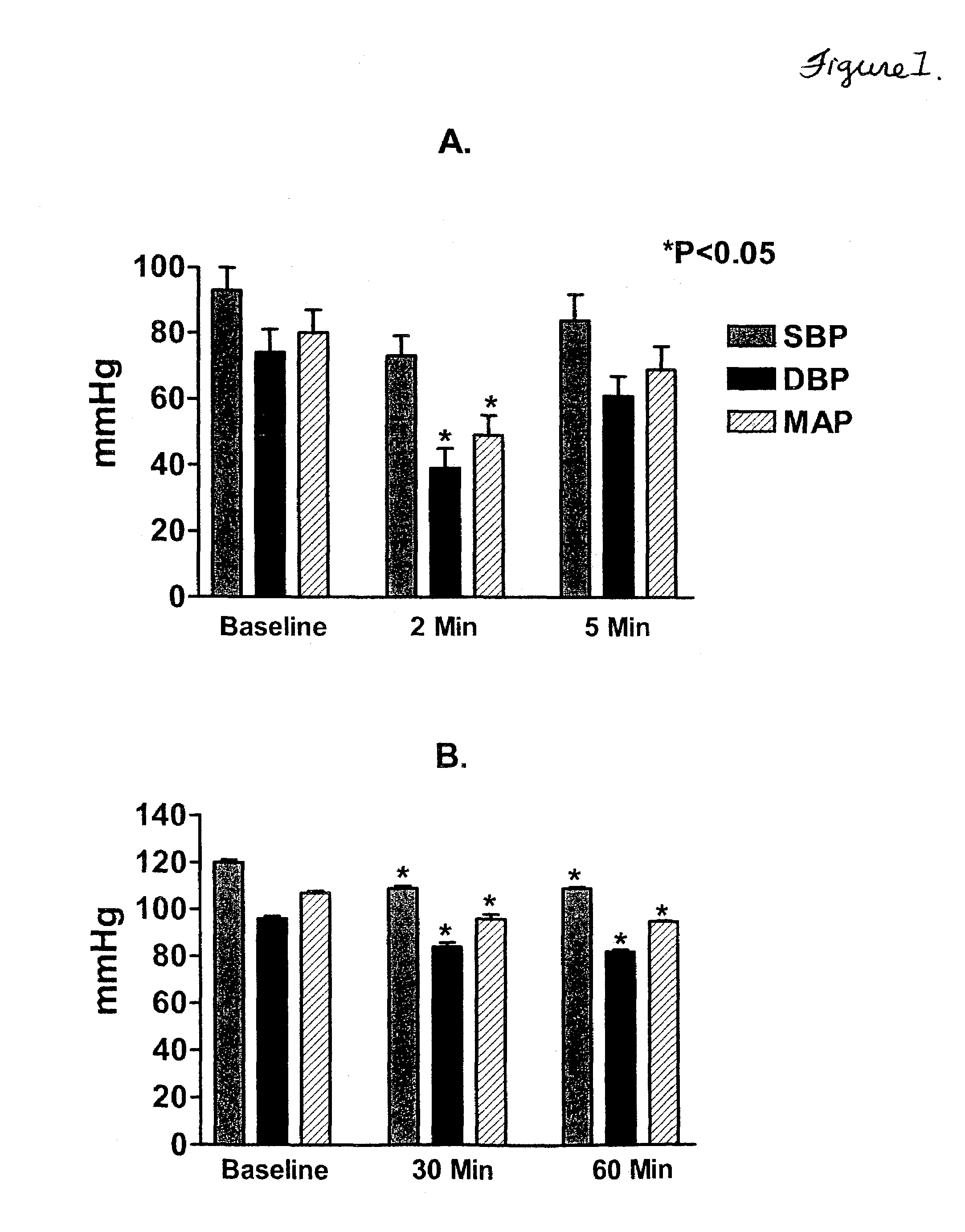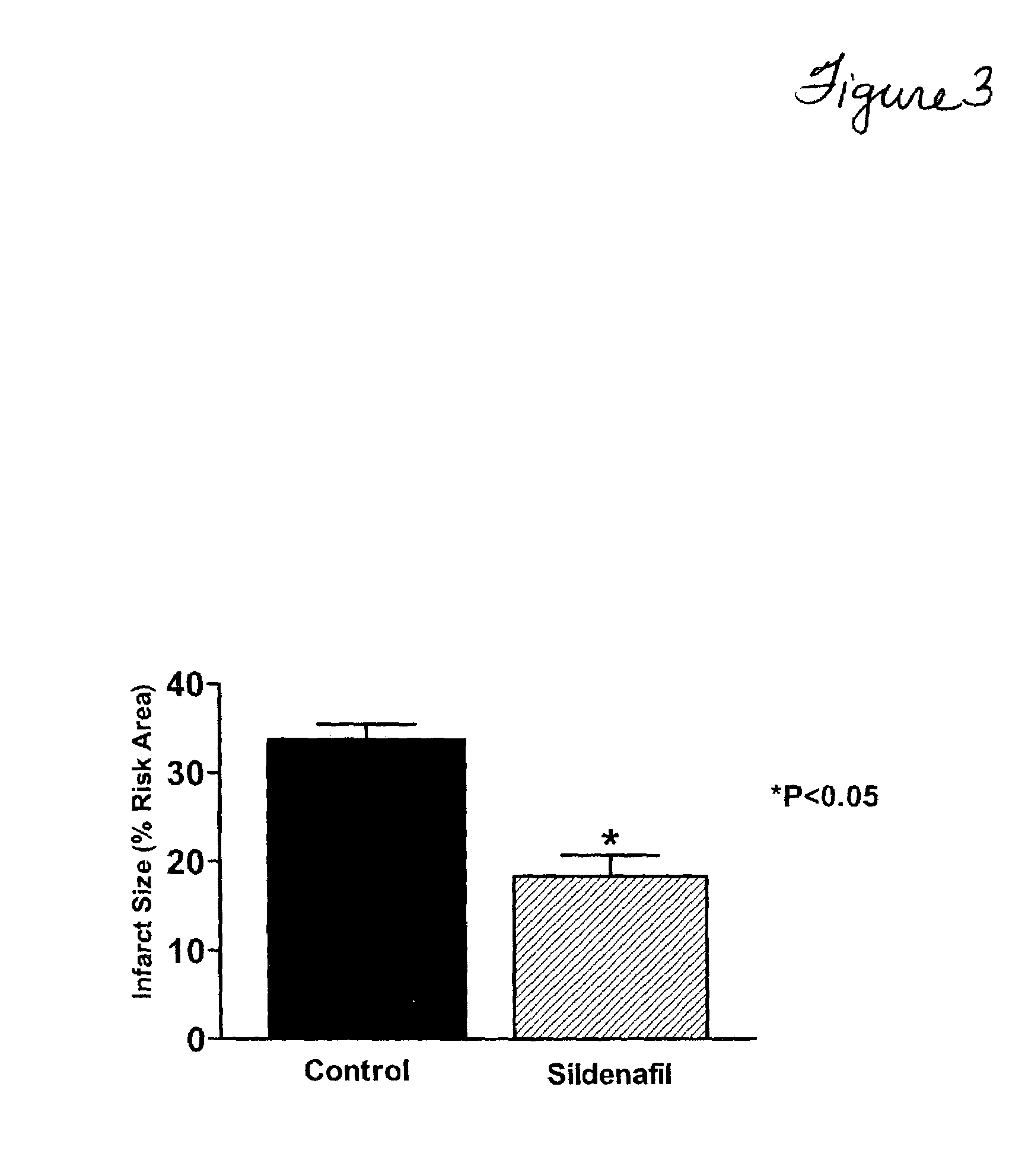Method of treating myocardial infarction with PDE-5 inhibitors
a technology of pde-5 inhibitors and myocardial infarction, which is applied in the field of prevention of ischemia/reperfusion injury, can solve the problems of increased number of people afflicted, unpredictable affect on quality of life, and potential for further damage to an already diseased heart, and achieves mild to moderate decrease in systolic and diastolic pressure, improves nitric oxide-driven cgmp accumulation, and improves the effect o
- Summary
- Abstract
- Description
- Claims
- Application Information
AI Technical Summary
Benefits of technology
Problems solved by technology
Method used
Image
Examples
example 1
Cardioprotective Effect of Sildenafil Citrate
Background
[0050]Sildenafil citrate (Viagra) is the first oral agent approved for treatment of erectile dysfunction in men (Cheitlin et al., 1999; Kloner and Jarow, 1999). It is a selective inhibitor of phosphodiesterase-5 (PDE-5), an enzyme that catalyzes the breakdown of a potent smooth muscle relaxing agent cyclic guanosine monophosphate (cGMP). Sildenfil has been shown to enhance nitric oxide (NO)-driven cGMP accumulation in the corpus cavernosum of rabbits without affecting cAMP formation. In the absence of NO drive, sildenafil had no functional effect on the human and rabbit isolated corpus cavemosum, but potentiated the relaxant effects of NO on these tissues (Wallis, 1999). Also, it has been shown that sildenafil causes mild to moderate decreases in systolic and diastolic pressure because of the inhibition of PDE-5 in smooth muscles in the vascular bed (Kloner and Zusman, 1999).
[0051]In the present studies, the ability of sildenafi...
example 2
Reduction of Infarct Size following Infusion of Sildenafil (Viagra) During End of Ischemia and Reperfusion
[0071]In continuation of experiments on the cardioprotective effect of Viagra in rabbit hearts (see Example 1), the effect of sildenafil on reduction of infarct size following its infusion during end of ischemia and reperfusion was tested. Rabbits were anesthetized and subjected to ischemia by occlusion of coronary artery for 30 min followed by reperfusion for 3 hrs as described for Example 1. Sildenafil (total dose 0.7 mg / kg) was infused beginning at 25 min of ischemia and continuing into reperfusion for 1 hr. At the end of reperfusion (3 hrs), the hearts were removed and infarct size was measured by TTC staining. The results showed a significant reduction in infarct size (18.37±2.42, mean±SEM, n=6) in the sildenafil treated group as compared to the saline group (33.76±1.72, mean±SEM, n=6, FIG. 3).
[0072]This example demonstrates that Sildenafil induces a cardioprotective effect...
example 3
Sildenafil Protects Against Necrosis and Apoptosis Following Ischemia / Reoxygenation in Cardiac Myocytes
Background
[0073]Etiologies of heart failure development are numerous and involve complex molecular mechanisms, not completely understood. However, recent advances have expanded our knowledge and understanding of the cellular and molecular mechanisms involved in the development of heart failure. Numerous studies involving both in vitro and in vivo models of have substantiated the evidence linking reduced oxygen species (ROS) to cardiomyocyte apoptosis (Koning et al., 1991). Apoptosis, commonly known as programmed cell death, is a regulated cellular process dependant on ATP that results in cell death for reasons that often are required in maintaining normal physiological function in many species (Wallis, 1999). For example, apoptosis is involved in the normal, regular, process of intestinal epithelial cell removal required for normal gastrointestinal function (Ockaili et al., 2002). ...
PUM
| Property | Measurement | Unit |
|---|---|---|
| temperature | aaaaa | aaaaa |
| tidal volume | aaaaa | aaaaa |
| thickness | aaaaa | aaaaa |
Abstract
Description
Claims
Application Information
 Login to View More
Login to View More - R&D
- Intellectual Property
- Life Sciences
- Materials
- Tech Scout
- Unparalleled Data Quality
- Higher Quality Content
- 60% Fewer Hallucinations
Browse by: Latest US Patents, China's latest patents, Technical Efficacy Thesaurus, Application Domain, Technology Topic, Popular Technical Reports.
© 2025 PatSnap. All rights reserved.Legal|Privacy policy|Modern Slavery Act Transparency Statement|Sitemap|About US| Contact US: help@patsnap.com



